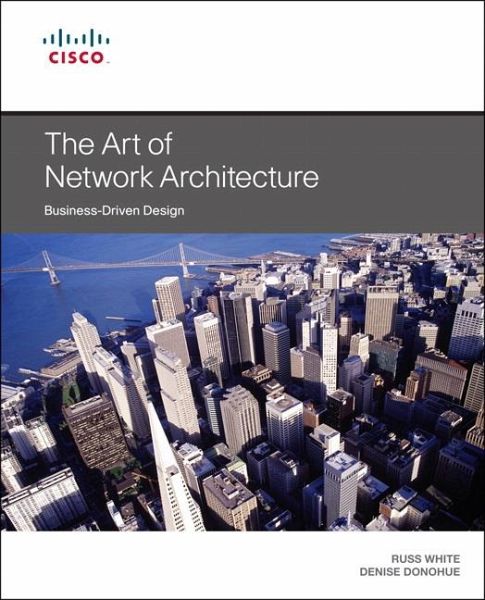
Art of Network Architecture, The: Business-Driven Design
Versandkostenfrei!
Versandfertig in 1-2 Wochen
44,99 €
inkl. MwSt.
Weitere Ausgaben:

PAYBACK Punkte
22 °P sammeln!
Today, both architects and business leaders understand the importance of networks to competitive advantage. Recognizing this, they are seeking better ways to architect and evolve networks based on the current and future needs of the business. The Art of Network Architecture is the first book that places business needs and capabilities at the center of the process of architecting and evolving networks, where it belongs.
Three pioneering network architects show how to evaluate both business and application requirements from a network designer’s perspective, identifying crucial upfront questions that can help you shape networks that support current business strategy and provide flexibility for the future. You’ll learn how to:
Deepen interactions between business and technology in your organization, and improve the effectiveness of those interactions
Face down challenges of complexity and cost in environments where the business changes faster than the network can
Frame the problem(s) and conceptualize the optimal network solution
Reflect operational realities, cost issues, and application support in your design
Fully leverage the benefits of modularity, hierarchy, and virtualization
Build networks that are more manageable and more resistant to security failures
Make better choices about topology, virtualization, and routing
The authors conclude with three chapter-length case studies: designing an L3VPN core; outsourcing to a cloud service; and supporting “Bring Your Own Device.”
Product Description
The Art of Network Architecture
Business-Driven Design
The business-centered, business-driven guide to architecting and evolving networks
The Art of Network Architecture is the first book that places business needs and capabilities at the center of the process of architecting and evolving networks. Two leading enterprise network architects help you craft solutions that are fully aligned with business strategy, smoothly accommodate change, and maximize future flexibility.
Russ White and Denise Donohue guide network designers in asking and answering the crucial questions that lead to elegant, high-value solutions. Carefully blending business and technical concerns, they show how to optimize all network interactions involving flow, time, and people.
The authors review important links between business requirements and network design, helping you capture the information you need to design effectively. They introduce today’s most useful models and frameworks, fully addressing modularity, resilience, security, and management. Next, they drill down into network structure and topology, covering virtualization, overlays, modern routing choices, and highly complex network environments.
In the final section, the authors integrate all these ideas to consider four realistic design challenges: user mobility, cloud services, Software Defined Networking (SDN), and today’s radically new data center environments.
• Understand how your choices of technologies and design paradigms will impact your business
• Customize designs to improve workflows, support BYOD, and ensure business continuity
• Use modularity, simplicity, and network management to prepare for rapid change
• Build resilience by addressing human factors and redundancy
• Design for security, hardening networks without making them brittle
• Minimize network management pain, and maximize gain
• Compare topologies and their tradeoffs
• Consider the implications of network virtualization, and walk through an MPLS-based L3VPN example
• Choose routing protocols in the context of business and IT requirements
• Maximize mobility via ILNP, LISP, Mobile IP, host routing, MANET, and/or DDNS
• Learn about the challenges of removing and changing services hosted in cloud environments
• Understand the opportunities and risks presented by SDNs
• Effectively design data center control planes and topologies
Features + Benefits
The first business-centered, business-driven guide to architecting and evolving networks
Three pioneering network architects show how to evaluate both business and application requirements from a network designer’s perspective, identifying crucial upfront questions that can help you shape networks that support current business strategy and provide flexibility for the future. You’ll learn how to:
Deepen interactions between business and technology in your organization, and improve the effectiveness of those interactions
Face down challenges of complexity and cost in environments where the business changes faster than the network can
Frame the problem(s) and conceptualize the optimal network solution
Reflect operational realities, cost issues, and application support in your design
Fully leverage the benefits of modularity, hierarchy, and virtualization
Build networks that are more manageable and more resistant to security failures
Make better choices about topology, virtualization, and routing
The authors conclude with three chapter-length case studies: designing an L3VPN core; outsourcing to a cloud service; and supporting “Bring Your Own Device.”
Product Description
The Art of Network Architecture
Business-Driven Design
The business-centered, business-driven guide to architecting and evolving networks
The Art of Network Architecture is the first book that places business needs and capabilities at the center of the process of architecting and evolving networks. Two leading enterprise network architects help you craft solutions that are fully aligned with business strategy, smoothly accommodate change, and maximize future flexibility.
Russ White and Denise Donohue guide network designers in asking and answering the crucial questions that lead to elegant, high-value solutions. Carefully blending business and technical concerns, they show how to optimize all network interactions involving flow, time, and people.
The authors review important links between business requirements and network design, helping you capture the information you need to design effectively. They introduce today’s most useful models and frameworks, fully addressing modularity, resilience, security, and management. Next, they drill down into network structure and topology, covering virtualization, overlays, modern routing choices, and highly complex network environments.
In the final section, the authors integrate all these ideas to consider four realistic design challenges: user mobility, cloud services, Software Defined Networking (SDN), and today’s radically new data center environments.
• Understand how your choices of technologies and design paradigms will impact your business
• Customize designs to improve workflows, support BYOD, and ensure business continuity
• Use modularity, simplicity, and network management to prepare for rapid change
• Build resilience by addressing human factors and redundancy
• Design for security, hardening networks without making them brittle
• Minimize network management pain, and maximize gain
• Compare topologies and their tradeoffs
• Consider the implications of network virtualization, and walk through an MPLS-based L3VPN example
• Choose routing protocols in the context of business and IT requirements
• Maximize mobility via ILNP, LISP, Mobile IP, host routing, MANET, and/or DDNS
• Learn about the challenges of removing and changing services hosted in cloud environments
• Understand the opportunities and risks presented by SDNs
• Effectively design data center control planes and topologies
Features + Benefits
The first business-centered, business-driven guide to architecting and evolving networks
The Art of Network ArchitectureBusiness-Driven DesignThe business-centered, business-driven guide to architecting and evolving networksThe Art of Network Architecture is the first book that places business needs and capabilities at the center of the process of architecting and evolving networks. Two leading enterprise network architects help you craft solutions that are fully aligned with business strategy, smoothly accommodate change, and maximize future flexibility.Russ White and Denise Donohue guide network designers in asking and answering the crucial questions that lead to elegant, high-value solutions. Carefully blending business and technical concerns, they show how to optimize all network interactions involving flow, time, and people.The authors review important links between business requirements and network design, helping you capture the information you need to design effectively. They introduce today’s most useful models and frameworks, fully addressing modularity, resilience, security, and management. Next, they drill down into network structure and topology, covering virtualization, overlays, modern routing choices, and highly complex network environments.In the final section, the authors integrate all these ideas to consider four realistic design challenges: user mobility, cloud services, Software Defined Networking (SDN), and today’s radically new data center environments.• Understand how your choices of technologies and design paradigms will impact your business• Customize designs to improve workflows, support BYOD, and ensure business continuity• Use modularity, simplicity, and network management to prepare for rapid change• Build resilience by addressing human factors and redundancy• Design for security, hardening networks without making them brittle• Minimize network management pain, and maximize gain• Compare topologies and their tradeoffs• Consider the implications of network virtualization, and walk through an MPLS-based L3VPN example• Choose routing protocols in the context of business and IT requirements• Maximize mobility via ILNP, LISP, Mobile IP, host routing, MANET, and/or DDNS• Learn about the challenges of removing and changing services hosted in cloud environments• Understand the opportunities and risks presented by SDNs• Effectively design data center control planes and topologies













